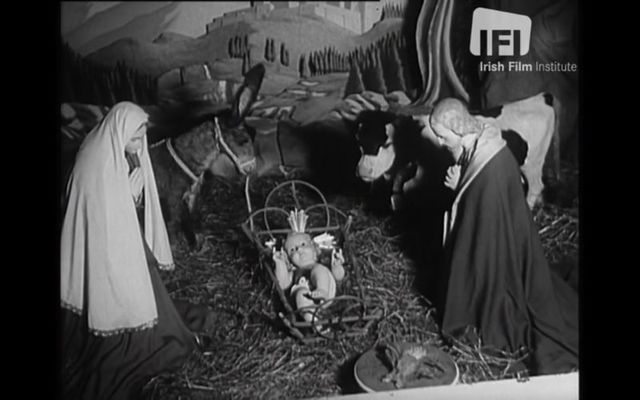"Moving Crib Tells Christmas Story," now streaming on the Irish Film Institute's IFI Archive Player, provides a look at a Dublin Christmas tradition in 1963.
A popular Dublin Christmas tradition was visiting The Moving Crib in Parnell Square. A nativity scene was created using over 100 mechanical, handcrafted figures set against a delicately hand-painted backdrop.
The Moving Crib (based at St Martin Apostolate, 30 Parnell Square) opened in 1956. Visitors can enjoy a colourful array of biblical scenes, from Adam and Eve and Noah’s Ark to the Christmas nativity. In 1977, the St Martin Apostolate relocated to 42 Parnell Street, where the festive event remains a popular attraction.
Produced by Gael Linn, Amharc Éireann (A View of Ireland) is Ireland’s longest-running indigenous newsreel series. It was distributed to cinemas nationwide to promote the Irish language. The first 36 issues were produced as single-topic films, released monthly, followed in 1959 by weekly, multi-story newsreels featuring a broad range of topics, from complex news stories to lighter magazine-style items. Between 1956 and 1964, 267 editions of the newsreel were produced for cinema exhibition.
To see more of the Gael Linn Collection, click here.
The Irish Film Institute's Gael Linn collection
Gael Linn was established in 1953 to promote the Irish language and culture. Co-founder and first manager, Riobard Mac Góráin, immediately realised the importance of promoting the language through entertainment and popular media. Gael Linn’s initial foray into production was the first regular indigenous cinema newsreel since the Irish Events series of the 1920s.
In 1955, Ernest Blythe, Chairman of Comdhail Naisiunta na Gaelige, lent Gael Linn £100 to produce a short film for cinema, and the Amharc Éireann (A View of Ireland) newsreel was born. From 1956 to mid-1957, Amharc Éireann consisted of short, single-story items distributed to cinemas throughout the country on a monthly basis. Their popularity was immediate, and by mid-1957, Rank Film Distributors agreed to supply them to Irish cinemas along with their own newsreel, after which they were issued on a fortnightly basis.
By 1959, the success of this home-grown newsreel led to its weekly production, and it expanded to include four separate news stories. The series continued until 1964, when the immediacy of television as a means of relaying news to the Irish population rendered the newsreel obsolete.
Produced by Colm O’Laoghaire, a total of 267 editions of Amharc Éireann were made. Although Gael Linn’s Amharc Éireann production ceased in late 1964, its influence endures. The range of Irish-interest subjects covered (from complex news stories to more magazine-like items) provides a vivid window into the development of modern Ireland at a particularly progressive point in its history and offers first-hand insight into the country's moral, cultural, and economic growth throughout the Whittaker and Lemass eras.
"Moving Crib Tells Christmas Story" is published here with kind permission of Gael Linn and with thanks to the Irish Film Institute (IFI), with whom IrishCentral has partnered up to bring you a taste of what their remarkable collection entails. You can find all IrishCentral articles and videos from the IFI here.
(For more Christmas content from the Irish Film Institute, check out their Christmas Crackers collection here!)
To watch more historic Irish footage, visit the IFI Archive Player, the Irish Film Institute’s virtual viewing room that provides audiences around the globe free, instant access to Irish heritage preserved in the IFI Irish Film Archive. Irish Culture from the last century is reflected through documentaries, animation, adverts, amateur footage, feature films, and much more. You can also download the IFI Archive Player App for free on iPhone, Android, Apple TV, Amazon Fire TV, and Roku.
IrishCentral has partnered up with the IFI to bring you a taste of what their remarkable collections entail. You can find all IrishCentral articles and videos from the IFI here.



